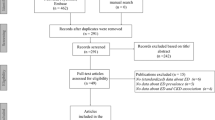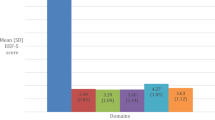Abstract
The aim of this study was to evaluate one possible reason why men do not seek help for erectile dysfunction. For this study, 500 men that visited their family doctors were stratified into one of three groups based on the reasons for their visits and their overall health statuses. A questionnaire was used to ask each participant about his willingness to seek help for erectile dysfunction should it occur during his lifetime. The statistical analysis of their answers showed that the men with serious chronic illnesses and malignancies were less interested in sexual activity, and they were less likely to seek help for erectile dysfunction when compared to otherwise healthy men and men with mild chronic diseases. Better patient education and reassurance could increase the proportion of men with chronic illnesses and malignancies who seek treatment for erectile dysfunction.
This is a preview of subscription content, access via your institution
Access options
Subscribe to this journal
Receive 8 print issues and online access
$259.00 per year
only $32.38 per issue
Buy this article
- Purchase on Springer Link
- Instant access to full article PDF
Prices may be subject to local taxes which are calculated during checkout



Similar content being viewed by others
References
Johannes CB, Araujo AB, Feldman HA, Derby CA, Kleinman KP, McKinlay JB. Incidence of erectile dysfunction in men ages 40–69: longitudinal results from the Massachusetts male aging study. J Urol. 2000;163:460–3.
Nicolosi A, Moreira ED Jr, Shirai M, Bin Mohd Tambi MI, Glasser DB. Epidemiology of erectile dysfunction in four countries: cross-national study of the prevalence and correlates of erectile dysfunction. Urology . 2003;61:201–6.
Akkus E, Kadioglu A, Esen A, Doran S, Ergen A, Anafarta K, et al. The prevalence and correlates of erectile dysfunction in Turkey: a population-based study. Eur Urol. 2002;41:298–304.
Rosen RC, Fisher WA, Eardley I, Niederberger C, Nadel A, Sand M. The multinational Men’s Attitudes to Life Events and Sexuality (MALES) study: I. Prevalence of erectile dysfunction and related health concerns in the general population. Curr Med Res Opin. 2004;20:607–17.
Hackett G. The burden and extent of comorbid conditions in patients with erectile dysfunction. Int J Clin Pract. 2009;63:1205–13.
Oken MM, Creech RH, Tormey DC, Horton J, Davis TE, McFadden ET, et al. Toxicity and response criteria of the Eastern Cooperative Oncology Group. Am J Clin Oncol. 1982;5:649–55.
Flynn KE, Lin L, Watkins Bruner D, Cyranowski JM, Hahn EA, Jeffery DD, et al. Sexual satisfaction and the importance of sexual health to quality of life throughout the life course of US adults. J Sex Med. 2016;13:1642–50.
Sanchez-Cruz JJ, Cabrera-León A, Martı́n-Morales A, Fernández A, Burgos R, Rejas J. Male erectile dysfunction and health-related quality of life. Eur Urol. 2003;44:245–53.
Shabsigh R, Perelman MA, Laumann EO, Lockhart DC. Drivers and barriers to seeking treatment for erectile dysfunction: a comparison of six countries. BJU Int. 2004;94:1055–65.
Shabsigh R, Stone B. Understanding the needs and objectives of erectile dysfunction patients. World J Urol. 2006;24:618–22.
Berner MM, Plöger W, Burkart M. A typology of men’s sexual attitudes, erectile dysfunction treatment expectations and barriers. Int J Impot Res. 2007;19:568–76.
Hosny KM, El-Say KM, Ahmed OA. Optimized sildenafil citrate fast orodissolvable film: a promising formula for overcoming the barriers hindering erectile dysfunction treatment. Drug Deliv. 2014;28:1–7.
Nelson CJ, Hsiao W, Balk E, Narus J, Tal R, Bennett NE, et al. Injection anxiety and pain in men using intracavernosal injection therapy after radical pelvic surgery. J Sex Med. 2013;10:2559–65.
Lowe WY, Ng CJ, Tan NC, Choo WY, Tan HM. Management of erectile dysfunction: barriers faced by general practitioners. Asian J Androl. 2004;6:99–104.
De Berardis G, Pellegrini F, Franciosi M, Pamparana F, Morelli P, Tognoni G, et al. Management of erectile dysfunction in general practice. J Sex Med. 2009;6:1127–34.
Almigbal TH, Schattner P. The willingness of Saudi men with type 2 diabetes to discuss erectile dysfunction with their physicians and the factors that influence this. PLoS One. 2018;13:e0201105 https://doi.org/10.1371/journal.pone.0201105.. eCollection 2018
Ball M, Nelson CJ, Shuk E, Starr TD, Temple L, Jandorf L, et al. Men’s experience with sexual dysfunction post-rectal cancer treatment: a qualitative study. J Cancer Educ. 2013;28:494–502.
Hartman ME, Irvine J, Kl Currie, Ritvo P, Trachtenberg L, Louis A, et al. Exploring gay couples’ experience with sexual dysfunction after radical prostatectomy: a qualitative study. J Sex Marital Ther. 2014;40:233–53.
Ratcliff CG, Cohen L, Pettaway CA, Parker PA. Treatment regret and quality of life following radical prostatectomy. Support Care Cancer. 2013;21:3337–43.
Hatzichristou D. Post-radical prostatectomy erectile function: the five Ws and the H. Eur Urol. 2012;62:287–9.
Chung E, Brock G. Sexual rehabilitation and cancer survivorship: a state of art review of current literature and management strategies in male sexual dysfunction among prostate cancer survivors. J Sex Med. 2013;10(Suppl 1):102–11.
Author information
Authors and Affiliations
Corresponding author
Ethics declarations
Conflict of interest
The authors declare that they have no conflict of interest.
Additional information
Publisher’s note: Springer Nature remains neutral with regard to jurisdictional claims in published maps and institutional affiliations.
Supplementary information
Rights and permissions
About this article
Cite this article
Bratus, D., Bratus, T. Men with serious chronic illnesses and malignancies are less likely to seek treatment for erectile dysfunction. Int J Impot Res 32, 180–185 (2020). https://doi.org/10.1038/s41443-019-0139-6
Received:
Revised:
Accepted:
Published:
Issue Date:
DOI: https://doi.org/10.1038/s41443-019-0139-6



